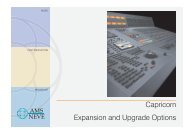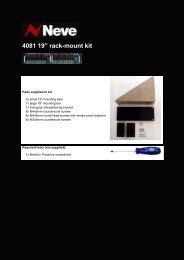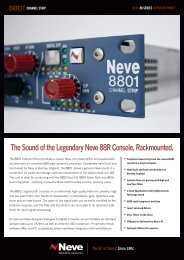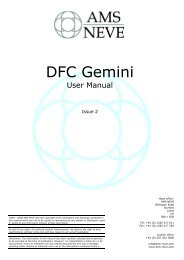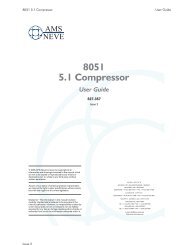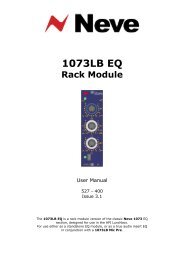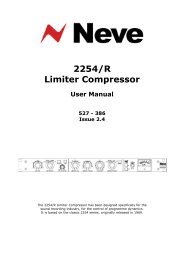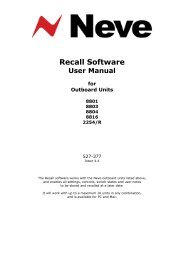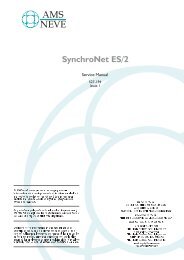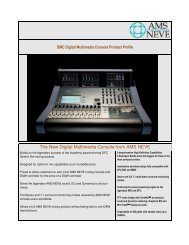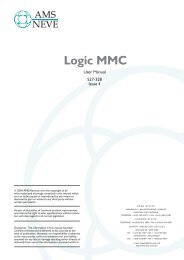Service - AMS Neve
Service - AMS Neve
Service - AMS Neve
- No tags were found...
You also want an ePaper? Increase the reach of your titles
YUMPU automatically turns print PDFs into web optimized ePapers that Google loves.
Digital <strong>Service</strong> ManualBackplane (SHN857-115)CARD DESCRIPTIONAudio connectorsAudio modules plug into 96 way DIN connectors J1 to J12. The top half of the connectorshandles analogue audio signals or AES audio signals, the bottom half of the connectorhandles the digital audio and clocks to the digital control module.A pair of boards makes up one audio module and the 16 signals to the two boards are splitbetween them as follows. Looking from the front the left hand board of a pair handleschannels 1, 4, 5, 7, 9, 11, 14 and 15. The right hand board handles 2, 3, 6, 8, 10, 12, 13and 16. If a fault is discovered in a module the channel number will therefore determinewhich of the two boards the fault is on.The audio signals comprise of three connections: H, C and G for ground. These signals aregrouped on a single row A, B and C of the 96 way connector. The 8 triples are interspersedwith the analogue power rails at the top of the connector.Below on A20, B20, C20 and A21 are the four ID lines which tell the board its address orposition in the rack. On J1 they are all low and this is read as 0 which is then translated asboard 1 by adding 1. On J2 ID0 is connected to +5V which is translated as board 2. This isused to map modules to MADI channels and to allow the desk and digital control module tobe able to address the boards individually with control messages.Rows 23 to 26 of the 96 way DIN connectors are the digital audio signals to and from thedigital control module. There are four signals IN to the rack and four signals OUT to theaudio board. Each signal carries a pair of digital audio channels so forming 8 digital outand 8 digital input lines for each board and therefore 16 in and out for each module. All arestandard TTL levels.Row 29 carries the balanced RS485 control lines to all the audio modules. Each of the twelveboards will respond to messages from the master module over this link. The digital controlmodule continuously polls the modules to check if any have been removed or replaced. Italso checks for switch press messages from the module front panels and transmits controlmessages to the audio circuitry on the audio modules. The link is an asynchronous pair of5V logic signals at 19.2kbaud which are in antiphase to each other.A30, A31 and C30 carry the three clocks used by the audio modules for synchronization tothe rack. A30 carries wordclock of (48kHz at a 48kHz system rate), C30 carries a bit clock(BCLK or SCLK) of 64 times word clock (3.072MHz at 48kHz sample rate) and A31 carries amaster clock (MCLK) of 256 times word clock (12.288MHz at 48kHz sample rate). All arestandard TTL levels.Digital Control Module connectorsThe digital audio and clock signals for the first 6 boards drop down to J15, the signals for thelast 6 boards are passed to the digital control module by J16.J16 also carries the following signals from the digital control module to J68 which is theconnector for the digital I/O card.Issue 3 Page 36




